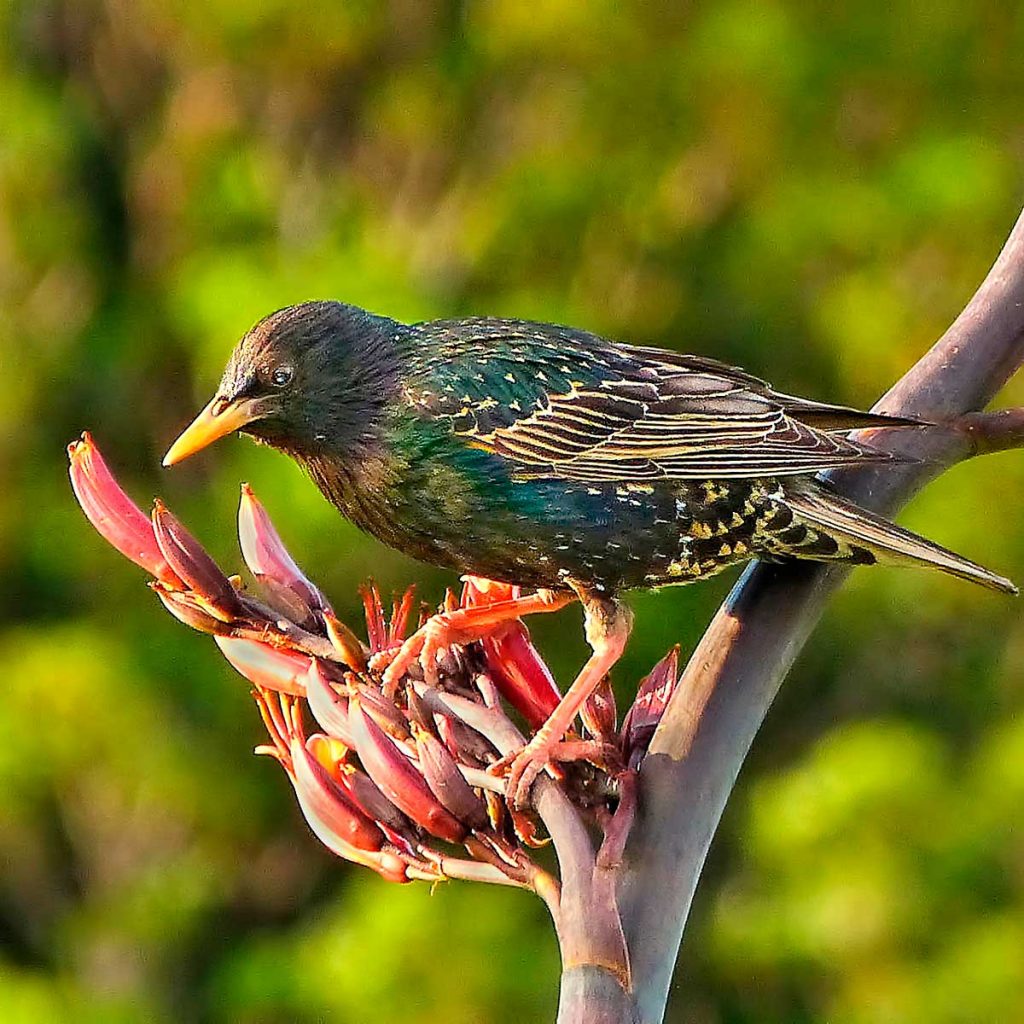
Birds / Starling
Information for Juniors
Starling
- The Starling was first introduced to New Zealand in 1862
- They can be found throughout mainland New Zealand
- The Starlings diet consists of insects, fruit, grain, eggs of ground breeding birds, and nectar from flowers such as Flax, kowhai and rata.
- Starling nests are untidy heaps of grass in holes in trees or buildings, or at the base of clumps of vegetation.
- The females lay four or five pale blue eggs
- There could be a second clutch later in the season.
- In the winter months Starlings gather in large flocks to roost at dusk.
- The male and female Starling are alike in size and colouring.
- Males and females are glossy black with a purple sheen on their heads and breasts.
- Their bills are yellow with a pink base for the females and a blue base on the males.
- Their wings and under-bodies have yellow-buff speckles, which, in winter, also extend over the breast and head.
What does it sound like?


Information for Junior Secondary
House Sparrow
- The Starling was first introduced to New Zealand in 1862 to combat an alarming rise in insects.
- They eat large numbers of insects, as well as seeds.
- Starlings can be found throughout mainland New Zealand.
- The Starlings diet consists of insects, fruit, grain, eggs of ground breeding birds, and nectar from flowers such as Flax, kowhai and rata.
- Starling nests are untidy heaps of grass in holes in trees or buildings, or at the base of clumps of vegetation. The females lay four or five pale blue eggs.
- A second clutch may come later in the season.
- In the winter months Starlings gather in immense numbers to roost at dusk.
- Some roosting flocks’ number a million birds.
- The male and female Starling are alike in size and colouring.
- In the breeding season, both males and females are glossy black with a purple sheen on their heads and breasts.
- Their bills are yellow with a pink base for the females and a blue base on the males.
- Their wings and under-bodies have yellow-buff speckles, which, in winter, also extend over the breast and head.
What does it sound like?


Information for Seniors
Starling
- The Starling was first introduced to New Zealand in 1862 to combat an alarming rise in insects caused by the wholesale destruction of bush as the land was cleared for agriculture.
- They were able to eat large numbers of insects, as well as seeds, so they could survive the winters. They were non-migratory, and they were prolific breeders, so that they could multiply and soon overcome insect pests.
- Starlings are found throughout mainland New Zealand, except in densely forested or mountainous country.
- The Starlings diet consists of insects, fruit, grain, eggs of ground breeding birds, and nectar from flowers such as Flax, kowhai and rata.
- Starling nests are untidy heaps of grass in holes in trees or buildings, or at the base of clumps of vegetation.
- The females lay four or five pale blue eggs, and about half lay a second clutch later in the season.
- In the winter months Starlings gather in immense numbers to roost at dusk. Some roosting flocks’ number a million birds.
- The male and female Starling are alike in size and colouring.
- In the breeding season, both males and females are glossy black with a purple sheen on their heads and breasts.
- Their bills are yellow with a pink base for the females and a blue base on the males.
- Their wings and under-bodies have yellow-buff speckles, which, in winter, also extend over the breast and head.
What does it sound like?


Activities
- What is the Starlings favourite food and from which trees?
- Is it the male or the female who has the most vocal repertoire of songs? Please explain in more detail.
- What is the purpose of their call generally?
- Draw the singing Starling and clearly indicate that you have studied it in detail.
- List 5 new facts that you have researched and find interesting.
